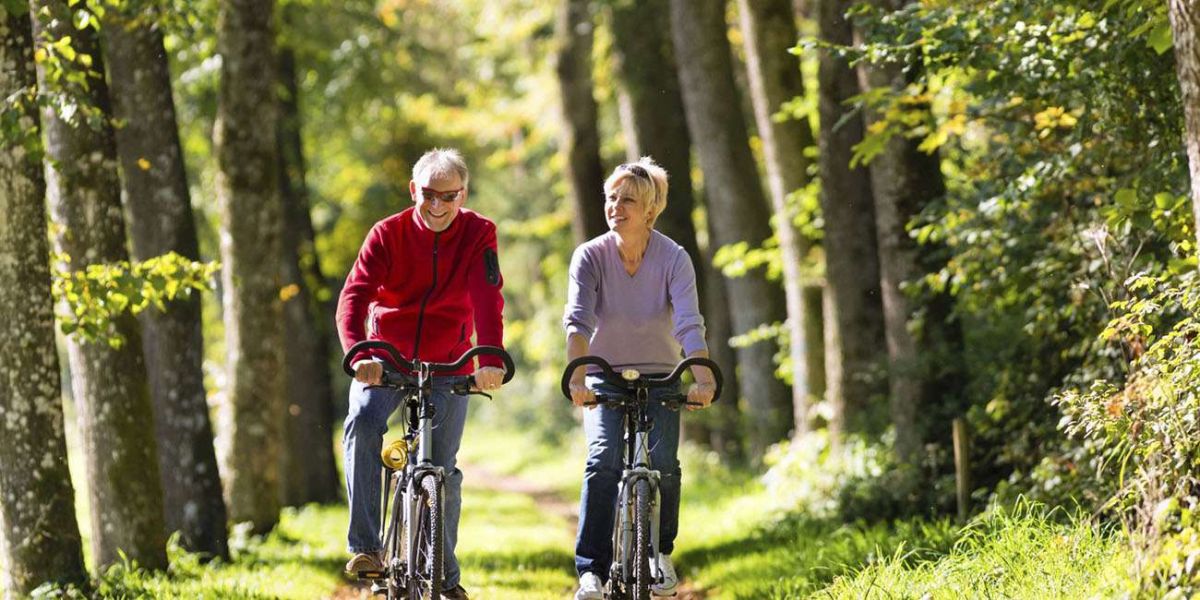Cycling, a versatile and sustainable activity, has long been popular among people of all ages, offering numerous health, environmental, and transportation benefits. It has captivated people’s hearts across generations due to its accessibility, cost-effectiveness, and eco-friendliness. From children learning to ride their first bike to seniors rediscovering the joy of cycling, this activity transcends age barriers and offers many benefits for everyone.
As a sustainable mode of transportation, cycling reduces greenhouse gas emissions and air pollution, contributing to a cleaner and healthier environment for all. Cycling also offers seniors an affordable and efficient means of transportation, fostering independence and encouraging exploration of their surroundings.
In this article, we’ll explore how seniors can ride a bike, discuss the safety aspects of cycling for older adults, and explore the myriad benefits of cycling, including its healing and wellness properties. Whether they are asking, “How can seniors ride a bike?” or “Is it safe for seniors to cycle?” the answer lies in the various advantages cycling provides, making it a worthwhile pursuit for seniors of all abilities.
Table of Contents
Best Time to Cycle and Ideal Distance
As seniors embrace the cycling world, it is crucial to consider the best time to cycle and the ideal distance to cover. Personal preferences, physical fitness, and weather conditions can influence these decisions.
Ideal Time of Day for Cycling
Choosing the ideal time for cycling for seniors can significantly impact the overall experience and the benefits of this activity. Generally, the best time to cycle is during daylight hours, which ensures better visibility and safer conditions for riders. Morning hours are often preferred, as temperatures are cooler and air quality is usually better.
It can be especially beneficial for seniors, reducing the risk of overheating or experiencing respiratory issues while cycling. Moreover, biking in the morning can offer a revitalising beginning to the day and a natural surge of energy that can endure all day long.
Recommended Distance for Seniors
Determining the ideal distance for cycling for seniors depends on various factors, including individual fitness levels, health conditions, and personal goals. For seniors new to cycling or inactive for a while, it is advisable to start with shorter distances and gradually increase the distance over time as their endurance and strength improve. A good starting point may be a 1-2 mile ride to increase the distance by 10-15% each week.
Longer rides may be appropriate for more experienced cyclists or those in good physical condition. In such cases, seniors can aim for a distance of 5-10 miles or more, depending on their comfort level and abilities. Seniors must listen to their bodies and adjust the distance according to their needs, considering factors such as fatigue, joint pain, or muscle soreness.
Benefits of Cycling for Seniors
Staying active is crucial for maintaining our health and well-being as we age. Cycling for seniors has become an increasingly popular way for older adults to stay fit, engage with their communities, and improve their overall wellness.
Physical Benefits
- Cardiovascular Health
Cycling for seniors is a fantastic form of low-impact aerobic exercise, promoting cardiovascular health by increasing heart rate and improving blood circulation. Consistent cycling can aid seniors in decreasing the likelihood of heart disease, high blood pressure, and stroke.
- Muscle Strength
As we age, muscle strength tends to decline. Cycling for seniors can help counteract this decline by working on major muscle groups, such as the quadriceps, hamstrings, glutes, and calf muscles. It helps seniors maintain strength and independence in their daily lives.
- Balance and Coordination
Cycling for seniors also improves balance and coordination. Riding a bike requires multiple muscles simultaneously, which helps train seniors’ proprioceptive senses, allowing them to maintain better control of their bodies in space.
Mental Benefits
- Stress Reduction
Cycling for healing can be a great way to reduce stress levels. The rhythmic, repetitive motion of pedalling and the opportunity to immerse oneself in nature can have a calming effect on seniors, promoting relaxation and a sense of well-being.
- Improved Cognitive Function
Engaging in cycling for wellness can enhance cognitive function by elevating blood flow to the brain and supplying essential nutrients and oxygen. It can help keep seniors’ minds sharp and potentially reduce the risk of cognitive decline.
- Increases Self-Esteem and Confidence
Mastering a new skill or achieving personal fitness goals through cycling can give seniors a sense of accomplishment, boosting their self-esteem and confidence.
- Enhances Mood
The act of cycling for wellness promotes the secretion of endorphins, which can assist in enhancing mood and diminishing feelings of depression or anxiety.
Social Benefits
- Group Rides and Social Interactions
Cycling for seniors often involves group rides, allowing older adults to interact with others who share their interests. It can lead to lasting friendships and provide a sense of belonging.
- Shared Experiences and Community Building
Cycling events and clubs allow seniors to engage in shared experiences, fostering community and camaraderie among participants.
- Motivation and Support
Riding with others can give seniors the motivation and support they need to stay active, as they can encourage one another to push through challenges and celebrate achievements together.
- Increased Accountability
Participating in group rides or events can help seniors maintain accountability for their fitness goals, as they are more likely to stay committed when they are part of a supportive community.
Cycling for seniors offers a wide range of physical, mental, and social benefits, making it an ideal activity for older adults looking to stay active and engaged. However, seniors must prioritise safety when cycling, ensuring they choose the appropriate equipment and follow best practices to minimise the risk of injury.
Safety Precautions for Seniors Cycling
For seniors to fully enjoy the benefits of cycling and minimise the risk of injury, it is crucial to prioritise safety and take necessary precautions, which include:
Pre-ride Safety Checks
- Checking tire pressure and ensuring the tires are properly inflated.
- Inspect the brakes for responsiveness and wear.
- Ensure the chain is clean, lubricated, and properly adjusted.
- Confirm that all bolts and quick-release mechanisms are secure.
- Verifying that lights and reflectors are functioning and visible.
Proper Attire and Equipment
- Wearing a well-fitting, certified helmet to protect the head in a fall or collision.
- Donning bright, reflective clothing increases visibility to other road users.
- Wear gloves for better grip and padded shorts for added comfort.
- Use a comfortable saddle, adjusted to the correct height, to reduce strain on joints.
- Equipping the bike with a bell or horn to signal other road users.
Weather Considerations
- Checking the weather forecast and avoiding cycling during extreme heat, cold, or inclement weather.
- Wear appropriate clothing for the weather conditions, such as rain gear for wet days or layered clothing for cold temperatures.
- Staying hydrated and taking breaks as needed, particularly on hot days.
- Applying sunscreen and wearing sunglasses to protect from harmful UV rays.
Traffic Safety and Route Planning
- Choose quieter roads or dedicated bike lanes whenever possible, avoiding heavy traffic or poorly maintained roads.
- Following traffic signals and signs, signalling turns, lane changes, and yielding to pedestrians are good driving examples.
- Stay alert and maintain a safe distance from vehicles, particularly at intersections and when passing parked cars.
- Carry a map, smartphone, or GPS device to help with navigation and route planning.
With proper planning and attention to safety, cycling can be a safe, enjoyable, and rewarding activity for seniors, contributing to their overall health and well-being.
Essential Gears for Senior Cyclists
Senior cyclists need to consider various factors when selecting essential gear for cycling. Comfort, safety, and ease of use are important to remember. Here are the types of equipment essential for senior cyclists:
- Comfortable Bike
Choose an ergonomically designed bike with a step-through frame for easy mounting and dismounting.
- Bike Helmet
A well-fitted, comfortable helmet is crucial for safety. Make sure it meets safety standards and has proper ventilation.
- Padded Cycling Shorts
Padded shorts provide extra cushioning and can help reduce discomfort during long rides.
- Breathable Clothing
Moisture-wicking, lightweight, breathable clothing will keep senior cyclists comfortable during rides.
- Cycling Gloves
Gloves with padded palms can help reduce vibrations and improve grip, leading to better control and reduced hand fatigue.
- Bike Saddle
A comfortable, cushioned saddle is essential for long rides. Consider a saddle designed specifically for seniors or with extra padding.
- Lights and Reflectors
Front and rear lights and reflectors are essential for visibility and safety, especially during low-light conditions or when riding at night.
- Rearview Mirror
A rearview mirror can help seniors monitor traffic and other cyclists, making it easier to navigate safely.
- Water Bottle and Holder
Hydration is important during any physical activity. Equip the bike with a water bottle holder and a water bottle to stay hydrated on the go.
- Panniers or Bike Bags
For carrying personal belongings, groceries, or other items, a set of panniers or bike bags can be helpful.
- Basic Tool Kit
A small, basic tool kit containing a multi-tool, spare tubes, and other essentials can be useful for minor repairs and adjustments during rides.
- Bell or Horn
A bell or horn can help make others aware of the senior cyclist’s presence, increasing safety on shared paths and roads.
Investing in the right gear can make a significant difference in the overall cycling experience for seniors, promoting safety, comfort, and accessibility.
Unlocking a World of Health, Happiness, and Personal Growth
Cycling for seniors is an incredible activity that promotes their health and wellness and allows them to explore the world around them. For seniors seeking new adventures and personal growth, cycling can take you to places literally and figuratively.
Now is the perfect time for seniors to embrace cycling and unlock its many benefits. By overcoming barriers, connecting with fellow cyclists, and exploring new places, seniors can embark on a rewarding journey of health, happiness, and personal growth. So, get on your bike and start enjoying the wonderful cycling world!

